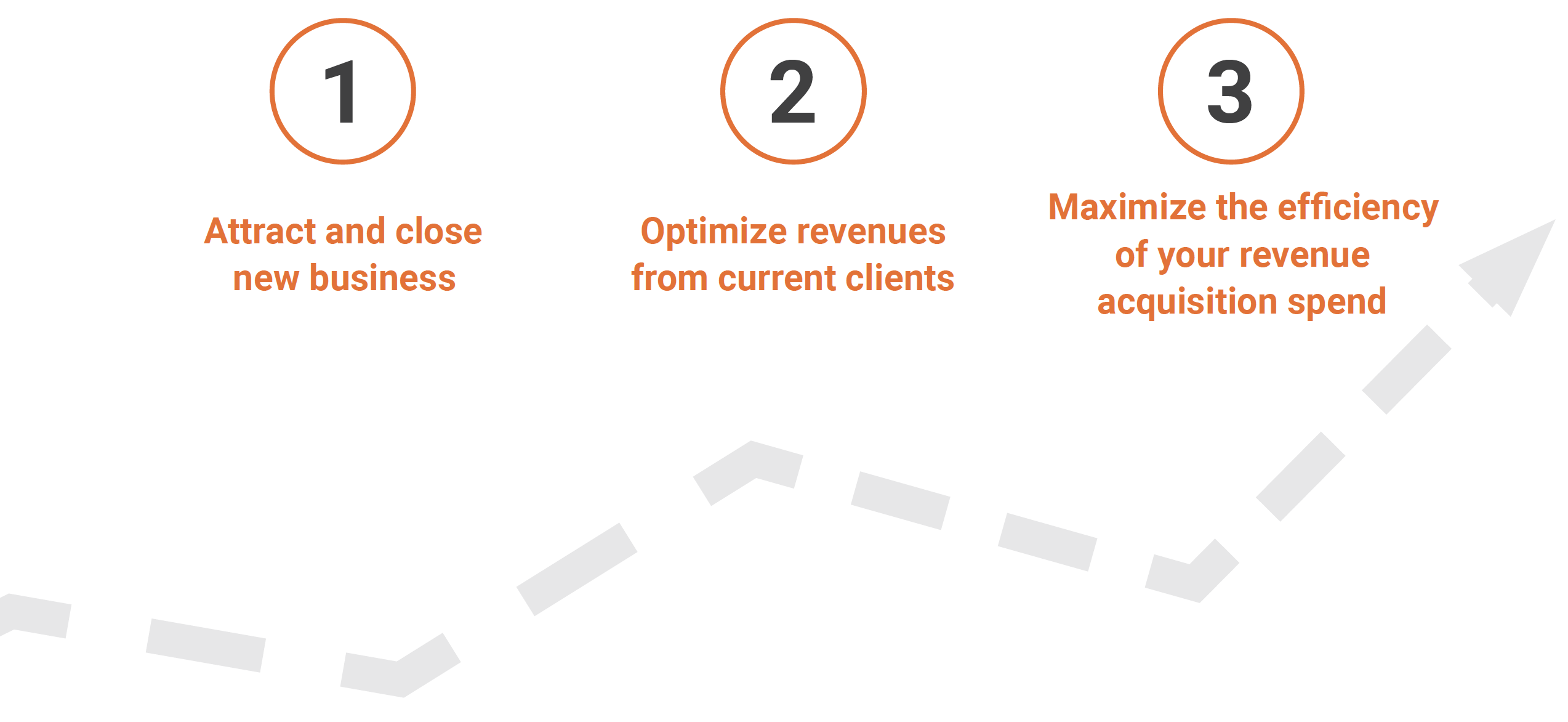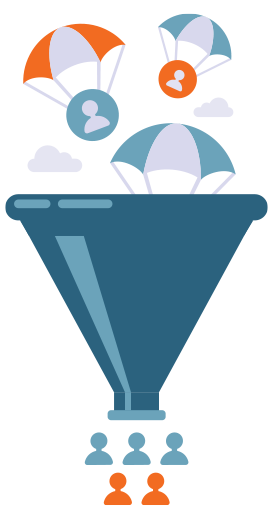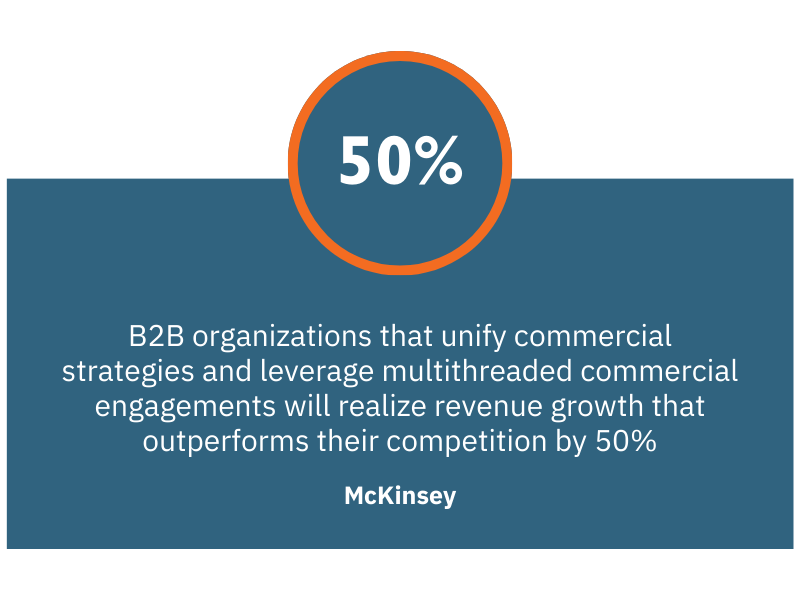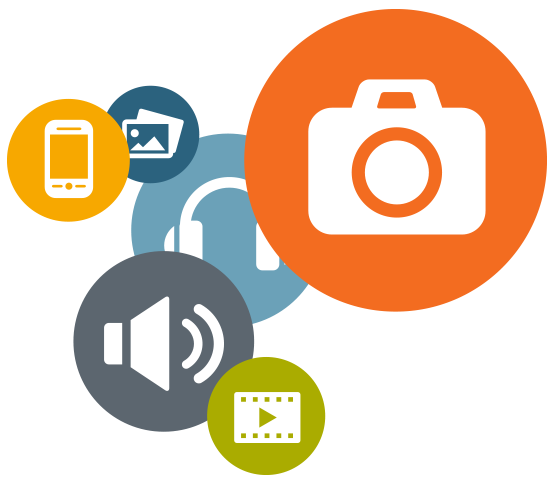This comprehensive guide provides the proven steps for creating a demand-gen engine that delivers quality leads and can adapt to the constant changes and shifts that have become the norm in our digital world.
Use the interactive Table of Contents on the left side of this page to navigate quickly among sections of the guide.
Want to take a copy with you or share it with colleagues?
It sounds simple. But it never is. And given the market uncertainty of the last few years, marketing and sales teams are continuously tasked to do more with less. That means you must be savvier and more agile in building and adapting demand generation to address your shifting business environment.
But there is good news: the shift to digital engagement is now woven into the fabric of how we operate. According to McKinsey, more than two-thirds of B2B buyers prefer a self-directed decision-making journey over engaging with a sales rep until the final stages of their process.
This accelerated adoption of online tools and the ease and convenience they bring has increased expectations for smooth and consistent customer experiences – from first awareness of a product to purchase and right through service. Companies need to double down on meeting those expectations while closely managing budgets. That means every element of your marketing program should be continuously evaluated and optimized to focus on meeting the new realities of prospect and customer (and competitor) behavior in this changed environment.
Marketing and sales are now digital-first – and it will stay that way.
What does that mean to the marketing professional charged with generating demand for products and services? Strategy and tactics may have changed, but the fundamentals haven't. Your job is still focused on:

And while you’ll need to continue to find new ways to connect with prospects and clients, the foundational elements of B2B demand generation also haven’t changed:
At its core, demand generation means creating a “want” for your products and services and, in turn, developing the full-funnel initiatives to support that momentum. For many, this approach may offer a shift in perspective from lead generation to pipeline opportunities, from being volume-driven to revenue-driven, and from getting the quickest results to getting the greatest results.
This guide will help you take a closer look at the key drivers of demand generation to create a custom attack plan for your business. It can help you start a program from scratch or fine-tune existing efforts. Through this process, you can build awareness, drive demand, accelerate your pipeline, and optimize your clients’ lifetime value.
Today, more than ever, B2B companies must strategically map out where, when, and how to maximize their marketing investments. Let’s get started!


Sales and Marketing
A tightly aligned sales and marketing team is one of the most important factors in demand generation success. But for many companies, that’s simply not reality. They see marketing’s job as highlighting the brand, running ads, and preparing for trade shows. Sales is responsible for contacting prospects and closing deals. But not anymore – at least, not if you’re interested in outperforming your competition.
These days, prospects usie all kinds of digital channels to learn about and compare products and services when making a purchasing decision. Marketing plays a much larger role in helping sales focus on the best prospects and getting the right information in front of them during the awareness and consideration stages of the sales process. And sales and marketing working together is key to closing more business. Today, this is a team sport.


Marketing plays a much larger role in helping sales focus on the best prospects and getting the right information in front of them during the awareness and consideration stages.
What Makes a Great Sales and Marketing Collaboration?
Communication and transparency.
An open and regular line of communication between the sales and marketing teams is a must. A culture of communication creates a healthy environment to discuss, refine, and agree on your top prospects and how to market to them to grow sales and revenue. It also means being able to hold frank conversations about what isn’t going so well and how to course-correct when necessary. Finally, it means agreement on how to report on the activities and key performance indicators (KPIs) important to the goals of the two teams.
Agreement on who you’re marketing and selling to.
Together, sales and marketing need to define and agree on target markets and accounts, decision-makers, buyer personas, pain points, and intent indicators. This focused approach ensures that marketing and sales are going after the same accounts instead of diluting their efforts by chasing disparate segments. While marketing can do great research, sales knows what’s happening on the front lines; together they create a complete picture. This will help marketing create stronger lead generation programs, including the right kind of content, and qualify leads more effectively.
A word on buyer personas: they are representations of your ideal customers and their characteristics based on research. They help you focus on and attract the right prospects to your business – those who are more likely to purchase and stay with the organization over time. They are critical to sales and marketing collaboration, content creation, product development, and sales follow-up – in essence, anything related to customer acquisition and retention.

While marketing can do great research, sales knows what’s happening on the front lines.
Agreement on processes for lead handling between the two teams.
Marketing has its metrics (campaigns created, engaged website traffic, conversions, SQLs generated, pipeline contribution) and sales has its own, too (deals closed, revenue). Each also can track conversion rates from one phase of marketing and sales to the next down through the pipeline. But agreement on shared processes for lead handling and metrics that indicate success is one of the most important elements of an effective collaboration. It brings clarity and accountability to the critical intersection between the two teams and their responsibilities.
Defining a service level agreement (SLA) between sales and marketing is a first step. An SLA lays out objectives the teams commit to, such as the number of qualified leads or amount of revenue from potential sales that marketing will generate and the sales activities that will follow. Both marketing and sales use the SLA to support each other based on concrete, numerical goals.
Another step is determining how to score leads and apply those scores in marketing and sales efforts. Lead scoring is a methodology for ranking leads to determine their sales readiness. Leads are evaluated based on a number of criteria that focus on a prospect’s interest, place in the buying cycle, and fit with the business. Companies can score leads in a number of ways but assigning points to criteria is one of the most popular.
Lead scoring helps companies figure out whether prospects need to be fast-tracked to sales or nurtured by marketing. Marketing and sales can improve their efficiency and productivity based on their shared understanding of the status of leads.
The key to effective lead scoring is discussion between both groups about what is important to measure and how to measure it. Which brings us right back to the first point above: constant communication between marketing and sales is critical. Reporting on and discussing results and adjusting when necessary is the only way to continuously improve the quality of leads generated – and sales closed.

Resources to explore:
HubSpot offers an SLA template that walks you through the process of creating and reporting on metrics and planning marketing and sales initiatives, communications between the teams, and reporting. It also offers a similar buyer persona template.

What to Do Now:
Agree on your target markets/accounts and the decision-makers you want to reach.
Set the budget for your sales and marketing efforts. Budgets define and focus resources. No company has unlimited resources. Don't plan as if you do. Plan to be super smart in how to best leverage your budget to deliver outsized results.
Agree on the characteristics that make up an ideal marketing-qualified lead that is ready to turn over to sales. Determine the factors and lead scoring process to generate leads on the marketing side and to know when to send them to sales.
Discuss campaign messaging and content. Start by examining how you can repackage existing material with minor updates and personalization directed at your target markets and buyers.
Determine the channels you will use for reaching out to your targets. Remember, 4+ channels deliver 300% greater results than 1-2 channels (according to Gartner).
Establish service-level agreements and other KPIs and develop a report format. Remember, metrics need to connect to business goals. Retweets, clicks, conversions, and calls sound great, but if you can’t tie them to growth, they don't matter.
Set a meeting cadence with key players to discuss ongoing efforts and report results.
What to Do Next:
Develop or refine your buyer personas and fill in any gaps in your marketing planning. Adjust your marketing outreach if necessary. For example, how customer-centric are your efforts at this point, and do you need to change them? Do you understand the entire buyer’s journey, from anonymous prospect to delighted client?
Determine which departments beyond marketing and sales need to have a voice in your initiatives and support.
Review your marketing technology and determine any gaps you need to fill for effective execution (for more on your MarTech stack, see sections 2 and 5).
Refine your metrics, reporting, and meeting cadence as needed.
Examine your review/revision process and adjust if necessary. Are there people who have not been involved to date who would be helpful to include?

Getting Personal
When was the last time you were infuriated by unwanted contact from a marketer or business development rep? Last week? Yesterday? This morning?
The odds are pretty good that you get emails and phone calls every day with offers you aren’t the least bit interested in. Get too many that waste your time, and you’ll never want to open emails or answer calls from those companies again.
Why does this happen? Because marketers are doing a bad job of segmenting, targeting, and personalizing their demand generation programs. But with some effort and the right tools, it’s a problem you can avoid.

Creating Strong Connections
Engaging the right people with the right messages at the right time helps you make stronger connections with prospects, who then are more likely to become customers. Consider these statistics from MailChimp on segmented versus non-segmented campaigns:

While those stats focus on email, the principle holds true across all channels and applies to all organizations. A company of any size that wants to generate demand and increase sales must take segmentation, targeting, and personalization into account. Even startups and small B2B companies should do so if they want to outperform their competition.
Segmentation, Targeting, and Personalization Defined
Setting up demand generation programs is a strategic exercise. Today’s prospects come into the sales cycle with more access to information and more educated than ever. Understanding segmentation, targeting, and personalization will help you bucket data into the right groups, know where prospects are in the buyer’s journey, and address them on their terms.

Segmentation
Focused at the account level. Segmentation means finding common, yet broad or high-level traits among prospects and addressing needs and pain points they share.

Targeting
Focused on the buying group for an account. In today’s environment, buying processes seldom feature just one decision-maker. Most B2B purchases involve a group of 4-7 people, including representatives of operations, finance, IT, procurement, and the end user. Effective targeting means tailoring your content to address the perspectives of each stakeholder
Personalization
Tailors your outreach and content so it speaks directly to each prospective account and individual. For example, you can personalize existing pieces of content to specifically mention a prospect’s company, even including their logo and branding in the visuals.
Understanding segmentation, targeting, and personalization will help you bucket data into the right groups.
Marketing Automation Plays a Key Role
At the very beginning of your marketing efforts, you might be able to get away with an Excel database to track customers, prospects, and marketing campaigns. But if you want to grow, you’ll need to graduate to a marketing automation platform. How do you know it’s time for marketing automation? When you’re collecting at least some prospect data, publishing good content, generating organic leads, and you want to scale your efforts for greater growth.
Marketing automation is the engine that allows you to target prospects with appropriate content when they’re ready for it. It’s essential for building lists, creating nurture streams, scaling personalization, and tracking engagement across marketing efforts.
Unsurprisingly, marketing automation relies on good data – the key to executing workflows that dial into the prospect and nurture them through their journey. It’s rarely as simple as organizing lists by title or location, but an exercise in understanding how to use data sets to serve up relevant information that will accelerate prospects through the pipeline.

Resources to explore:
With more than 11,083 marketing automation options available today, it might be hard to know where to get started. The blog, “Choosing the Right B2B Marketing Automation Platform” offers pros and cons to consider about four of the most popular marketing automation platforms. The final section of this demand generation guide discusses how marketing automation fits into the entire collection of marketing technology (the MarTech stack) in an organization.

What to Do Now:
It’s time to get smarter about which businesses are your ideal customers and what that means in terms of better database segmentation, targeting, and campaign personalization. Don’t overlook this process for current customers. Marketing tends to focus heavily on “net new” clients, but revenue growth from current clients often comes at a lower cost of acquisition. Start at the top level by reviewing your prospect and customer data and using it to segment, target, and personalize your marketing efforts. The following are examples of useful data; there are many more to consider.
Demographic
Engagement
Organization
Deal Stage
Actionable Insights
Content Interactions
What to Do Next:
Further review the data you’re collecting and its integrity and develop a system to keep it up-to-date and accurate. Maintaining a clean database is key to good segmentation, targeting, and personalization.
Revisit your marketing planning and buyer personas and make sure you understand prospect needs and pain points. Map out how and when to address them in the content you create.
Evaluate/optimize your technology to ensure that it can support automated lead acquisition campaigns, ongoing customer nurture, and analytics.

Filling the Funnel
Successful marketing is no longer product- or service-centric – it is customer-centric. One critical shift that speaks to that change is the reliance on content marketing to inform, educate, entertain, and nurture customers through the buyer journey.
Content is everywhere – a barrage of information in varying degrees of accuracy and usefulness on every topic imaginable. The challenge for the buyer isn’t finding information on a particular subject; it is discovering trustworthy, useful, and relevant information on that subject. For marketers, the challenge is finding ways to get noticed, stand out, and be recognized as an expert source to address a particular need or pain point. B2B buyers want to be educated, not sold, and content must be engaging and intentional to generate interest, opportunities, and ultimately the sales and revenue you’re working so hard to generate.
Since different people learn in different ways, it’s also a marketer’s job to deliver content in different formats and at varying levels of detail and complexity. As buyers get more savvy, your conversations with them need to advance as well.
It’s a new world, and when it comes to demand generation, content is . . . well, you know the phrase.


Getting Your Content Plan Together
B2B doesn’t mean we need to be B2Boring. Our group of buyers is made up of individuals – people who are in different stages of the buyer’s journey with their own preferences about how and where they want to receive information. A healthy mix of different content formats, delivered in multiple ways, will help you engage and connect with more people and move them through your pipeline faster.
When developing content for demand generation, here’s a trick: use the journalist’s classic “5 Ws and 1 H” – with the order swapped around a bit – to help you create a plan.

Who do you want to reach?
For B2B organizations with complex sales cycles, you aren’t selling to just one person, you’re selling to a group of people. Different parts of the organization that have a stake in the decision are coming to the table with their unique points of view. Do you know who has a seat at the table? Do you understand the issues that influence how they’ll evaluate your solution?

What do you want to say to them?
Your value propositions must be woven into every piece of content, as does your organization’s knowledge and expertise. The reader is less interested in what you do than they are in how your solution helps them. Focus on the “So What” of your offering -- from the viewpoint of the customer -- and then your content has the opportunity to connect.

Why will they be interested in what you have to say?
Too often, B2B organizations focus on what they want to communicate to people, not what their prospects want to hear about. Your content needs to provide value to them: address their pain points, solve their problems, offer helpful industry information or perspective. The overlap between the information they need and the information you want to share is where your content should live.

How are you going to present it?
Content has evolved to include everything from articles, blog posts, and ebooks to video, podcasts, presentations, webinars, infographics, social posts, gaming – and more. Different buyers digest information differently. Some may prefer to read an article, while others want to watch a video. So a healthy mix of formats increases your chances to connect with all of them.
Remember the Goldfish Rule!!!
Attention spans have gotten progressively shorter (goldfish have an attention span of 9 seconds!). You may earn a few minutes for great content, but you'll definitely get more engagement with "snackable" content. Readers and viewers want to know upfront how long it is. If it's more than 3 minutes, they may not bother.
In addition, you need to consider what types of content tell your story most effectively. Some subject matter might be highly visual and translate well to video. Other topics need more explanation and do best in writing. Often, your subject matter will do well in multiple formats.

Where do they want to see it?
People not only have preferences for types of content; they also have places – channels – where they like to receive it. You can listen to podcasts on multiple players or via the web. Some like LinkedIn; others prefer Instagram; and even TikTok is now a source of news and B2B content for younger professionals.

When in the nurture or sales process do you deliver specific pieces of content?
Mapping content and other touchpoints to the buyer’s journey is critical. If someone is in research mode and downloads a white paper from your website, that doesn’t mean he or she is ready for a conversation with sales. After you add contacts to your inbound marketing database, what additional content do you offer, and when do you offer it, to keep them engaged and moving toward an eventual purchase?
Revising and Repurposing
Content takes resources – time, money, expertise – to produce. You will always need to create some from scratch. But you can maximize your resources and content through repurposing – one of the sweetest words in marketing today.
Repurposing simply means taking a piece of content – usually a long-form piece such as a Guide or eBook – segmenting it and using it in different formats. Take this guide you’re reading, for example. From this one piece we've created at least a dozen more: multiple blog and social posts, infographics, video and articles. You also can take short pieces of content and turn them into longer ones: blog posts to eBook, for example.

Measuring Results
Before you roll out content, decide how you’re going to measure engagement levels for results and ROI. Consider interactions, but follow those through to cost per lead, cost per qualified lead, and close. Measuring how content impacts your pipeline and close rates will show how it contributes to your organization’s success; it also will help you evaluate and adjust content that isn’t working or make additional use of content that is.
Measuring how content impacts your pipeline and close rates will show how it contributes to your organization’s success.
Resources to explore:
HubSpot’s “How to Develop a Content Strategy: A Start-to-Finish Guide” will walk you through creating a content marketing plan.

What to Do Now:
If you haven’t already done so, gather your content in one place so you know what you have to work with.
Conduct a content audit – a catalog of your existing content by subject matter, type, buyer, and other parameters. To get started, download our Content Audit Worksheet. Use the audit to:
Consider content to repurpose:
What to Do Next:
Now that you know the content you have available, the bigger problem is usually the content you don’t. With the planning you’ve completed, both marketing- and content-wise, and knowledge of upcoming priorities and campaigns, you should see what’s missing. To further develop your content marketing plan:
Identify gaps in coverage by persona, pain point, buyer stage, and content type.
Set priorities for filling those gaps.
Identify resources and timelines for content creation.
Set a budget for content development.

Multichannel Marketing
Targeted, engaging content is only as effective as the channels on which it’s distributed. While content is the engine that powers your demand generation program, channels are the roadways you use to deliver it to your prospects where they want to see it. The number of channels to choose from may seem overwhelming, but there is a method to understand and compare them that will help you figure out the right multichannel mix for your program.
Why Use Multiple Channels?
Marketers need to publish content on multiple channels for one good reason: the strategy works. Research by Gartner found that marketing campaigns using four or more digital channels outperformed single- and dual-channel campaigns by 300%. Because individuals have preferences for both the type of content they consume and where they consume it, engaging prospects in more than one location greatly improves your chance of conversion and revenue generation.
Connecting with prospects across multiple channels does mean you’ll need to address the battle of quantity versus quality. A targeted multichannel strategy focuses on attracting high-value prospects instead of trying to connect with a more general audience to flood the top of the funnel.


Choosing the Right Touch Points
Selecting the right channels for your buyers and synchronizing touch points across them to coincide with their buyer’s journey will transform your demand generation efforts. But so many possibilities exist today; how do you choose? The PESO model* will help. PESO stands for Paid, Earned, Shared, and Owned. It segments all the marketing channels at your disposal into discrete groups so you get a clear picture of what’s available, their pros and cons, and how they can work together.

Paid channels: you pay to participate (print and online publications that offer sponsored content and advertising, online advertising channels and platforms, content syndication).
Earned channels: you convince them to let you participate (business and trade publications, websites that accept contributed content, influencer properties such as websites and newsletters). Participation in these channels generally requires typical PR activities – demonstrating expertise and building relationships that result in interview or writing opportunities.
Shared channels: you participate, but so do others (social media). You control your own social properties, but your followers are free to interact with your content, positively or negatively.
Owned channels: no one can participate without your permission; you control the channel and content (your company website, email).
There are other types of channels in each bucket, and overlap between them, too. For example, influencer attention can be entirely earned, or you can pay to engage influencers as advocates (particularly in the consumer world).
All channels have their pros and cons in terms of authority, cost, reliability, scalability, speed, and potential contribution to the success of your demand generation program. When you’re putting together your plan and considering channels, do your research and determine the mix that best fits your goals, your brand, and your budget.
*Created by digital marketing expert Gini Dietrich and first published in Spin Sucks in 2014. The model has been widely adopted and expanded upon since.
Resources to explore:
Gartner offers insight into multichannel marketing in its research guide, Developing an Effective Multichannel Marketing Strategy. HubSpot also addresses multichannel marketing in detail in their post, “How to Launch a Successful Multichannel Marketing Strategy.”

What to Do Now:
Using multiple channels to get your message out may already be part of your strategy. The following can help you review your efforts or jumpstart a multichannel marketing approach.
Document each touch point with prospects.
Add each channel to your content map.
Examine your existing content across channels for messaging consistency. Prioritize clean-up where needed.
Evaluate the performance of each channel. If it’s underperforming, determine if the channel is a poor fit or you aren’t using it effectively. Revise or discontinue as appropriate.
Identify gaps and places where you can create a quick win.
What to Do Next:
Truly integrated campaigns need automation and technology support to scale your efforts. Technology is the tool to help you execute campaigns, so start with your goals and work backwards from there. Then match the technology to your program.
Creating multiple touch points requires up-to-date knowledge of buyers, where they get their information, and the technologies and thought leaders in their space. Researching this foundation is not a one-time exercise; it should be reviewed and updated regularly.
An increasing number of touch points will increase the complexity of lead attribution. Understand how you’ll track your campaigns and where you’ll need UTMs (tracking information added to URLs so you know how prospects found you), what the system of record will be for pulling reporting, and the communication cycle for discussing results.

The MarTech Stack
There is no denying the role of technology in today’s demand generation programs. Technology is essential for scalability, to automate campaign tactics, and to optimize and improve efficiencies of marketing programs through actionable reporting. However, all too often, technology is confused with strategy.
It’s not a strategy.

Technology is a tool that allows you to execute strategies. But it’s an important one and implementing the right MarTech stack will optimize your marketing processes, measure the impact of marketing activities, and drive more efficient spending. More to the point, it will help you build customer relationships across multiple channels, which ultimately can drive demand and contribute to revenue growth. But you need to make sure you’re using your technology to its full potential, so knowledge of your options and regular evaluation of new platforms is critical to success.
An Optimized Stack
Your MarTech stack is a specific combination of technologies that, when successfully integrated, will help marketing and sales better attract, convert, nurture, and retain customers.
Understanding your MarTech stack and developing a strategy for managing and adding platforms allows you to better align your technology budget with your organization’s goals. As you develop your unique stack, keep in mind how technologies work together to create an ecosystem that will drive revenue and growth.

Most organizations create a MarTech stack with the following core components:
Don’t Let Your Stack Get Stale
Marketing and sales professionals are now faced with the “MarTech 15,000” – thousands of options for building out your stack. One estimate in the State of MarTech 2022 report says that 120 is the average number of SaaS marketing technologies at any given company. And the number of options is only expected to grow.
The fact is, marketing technology, like all technology, is evolving quickly. Each year new solutions hit the market, offering more precise data, advanced techniques, and greater amplification. Your MarTech stack probably won’t be the same next year, or the year after that.
Your process should include examining new offerings and evaluating them against your current platforms and needs. Most experts recommend that about 15% of your MarTech spend be allocated to new tools each year. Evaluation becomes a key tactic in optimizing your stack.
Each year new solutions hit the market, offering more precise data, advanced techniques, and greater amplification.

Resources to explore:
Read and download our MarTech stack template from our blog “How to Build a MarTech Stack.” MarTech Today published a case study of one company that had to rethink its MarTech stack during the pandemic. HubSpot offers tips on creating your stack in this post, “How to Build a Marketing Technology Stack That’ll Grow With You.”

What to Do Now:
If you’re doing any type of marketing and sales today, you’re already using technology. No matter how minimal or sophisticated your stack might be, review how it is contributing to revenue generation today and optimize what you already have.
List all your current tools and their purposes.
Grade your utilization level for each tool. Do you have the right people with the right training? Do you need to upskill or outsource operations for better performance?
Map each tool to the stage of the buyer’s journey it impacts.
Record the number of users.
Note contract renewal dates.
Make a few quick decisions about each platform:
For a quick win, downgrade or eliminate any unused, underused, or overlapping technologies you can.
What to Do Next:
Continuing to optimize your MarTech stack means evaluating internal goals, needs, and resources against a constantly evolving technology marketplace. Planning is essential for progress, as is helping others understand the reason for any changes you need to make. Often times having a marketing automation platform like HubSpot is a great starting point to consider when looking to optimize your tech stack.
You’ll be collecting a tremendous amount of data as you execute your programs. Your efforts are only as good as that data. Make sure that data integrity is a key component of your program.
Automation doesn’t mean set it and forget it. You still need to monitor and adjust automation tools to generate desired outcomes.
People are more willing to adopt tools that make their lives easier. Even if they believe a solution will solve a problem or help them meet goals, it still can take some persuasion to get team members onboard. A successful technology implementation requires understanding and buy-in from everyone involved so that tools are used – and used properly.Based on your technology audit, determine gaps in your MarTech stack and assign team members to research and test tools to fill those gaps. Prioritize additions based on your needs and budget and what will produce the biggest wins.
Establish a MarTech governance structure. This is a framework for the continued evaluation of your stack. A governance structure ensures that you are intentional about reviewing new solutions and eliminating unused ones. It also can support adoption of them.
In Closing...
Demand Generation is a vital responsibility of B2B Marketers - and it's constantly evolving. Buyer preferences and habits change, our target markets shift and the tools we use are in constant flux flux. The keys to staying ahead of the game include establishing productive sales and marketing collaboration, effective use of targeting and personalization to better connect with prospects, leading with relevant content, taking a multi-channel approach, and optimizing your MarTech stack. Together these 5 elements will guide your organization to reach its core goal: improving revenue acquisition rates.
By understanding how to craft and apply these key elements, you are better equipped to create a custom plan that will produce quick wins while revving up your demand generation engine for long-term success.
Need outside expertise and a fresh perspective to spark your Demand Gen programs? Marsden Marketing's team of strategists, creatives and Demand Gen Specialists are ready to help.
B2B growth marketing+pr agency Trevelino/Keller acquired Marsden Marketing in 2024, including its industry-leading MM Growth Marketing solution, powered by a data-forward approach rich in technologies including HubSpot, Salesforce and Pardot.
1042 Northside Drive NW
Suite 960
Atlanta, GA 30318
(404) 214-0722
info@marsdenmarketing.com